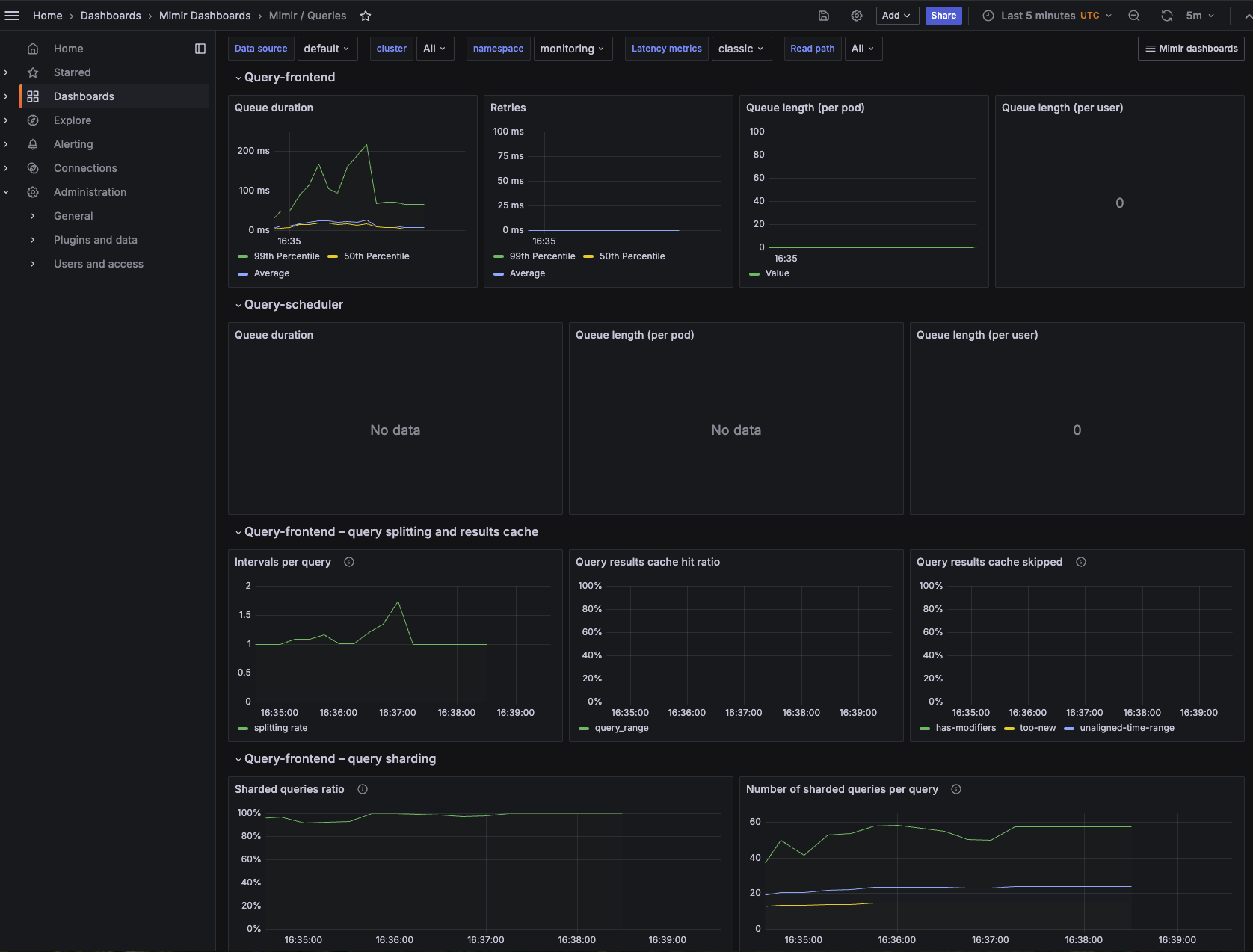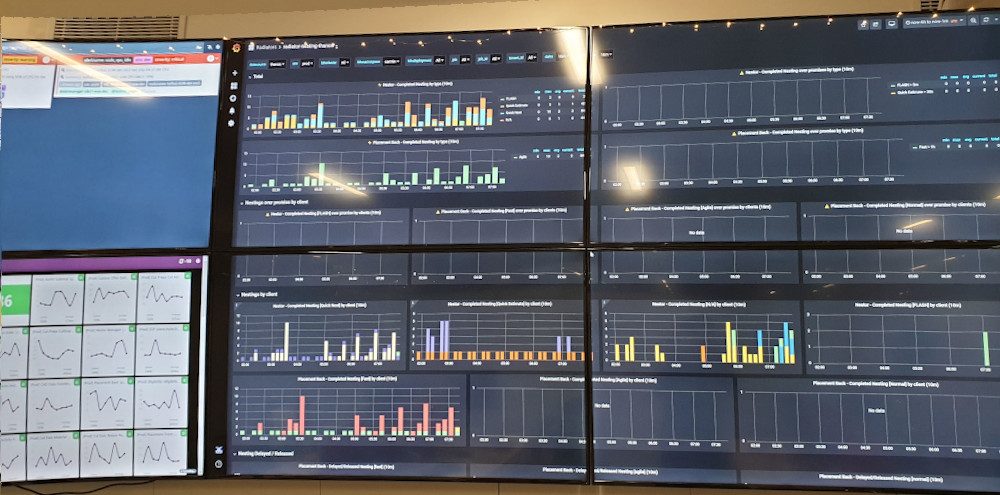Note : une fois de temps en temps, j’écris un article en anglais. Parfois c’est pour le fun, ici c’est parce que le sujet est très (très) niche et je veux qu’il touche potentiellement un peu plus de gens. Désolé pour les non-anglophones ;-)
Context
When working on observability, there is a tool that always comes in mind first : Grafana.
Grafana is an open source visualization tool developed by Grafana Labs, and I’m sure you all know it (and I also wrote about it in French quite a few times). But aside from this, they also develop a lot of other useful tools in the observability landscape, to the point that you can in theory build you whole o11y stack with only Grafana Labs Tools.
To answer Prometheus lack of long term storage and lack of high availability features (I have NEVER understood why the Prometheus team refuse working on this), Grafana Labs forked Cortex a few years back and renamed it Mimir.
I won’t cover the installation of Mimir here, there are plenty of tutorial on the Internet and an official documentation for this.
Instead, I’ll talk about an issue that I have with the official Mimir helm chart, and more precisely with the built-in Grafana dashboards that come along with it.
Dashboards, you say?
Mimir is shipped with a lot of useful Grafana dashboards to help ensure that the components are running fine.

These dashboards are compatible with the various deployment modes of Mimir. In Kubernetes, if you use the mimir-distributed official helm chart this can be enabled by a simple value:
metaMonitoring:
dashboards:
enabled: true
But, by default, all dashboards installed using the metaMonitoring value in the mimir helm charts are precompiled JSON manifests using jsonnet/mixin.
For example, here is the precompiled version of the “Mimir / Overview dashboard”:
By design, you can’t change things like the prefix name of the mimir pods, which makes these precompiled dashboards useless in a helm-like environment where release name (mimir-) is a prefix of the pod.
kubectl -n monitoring get pods
NAME READY STATUS RESTARTS AGE
mimir-alertmanager-0 1/1 Running 0 24h
mimir-alertmanager-1 1/1 Running 0 24h
mimir-compactor-0 1/1 Running 0 24h
mimir-distributor-5d668b479f-ksltr 1/1 Running 1 (24h ago) 6d1h
...
In this case, all dashboards will be broken, all showing “no data” in Grafana because data will be incorrectly filtered. For example, the “Write requests / sec” panel in “Mimir / Overview dashboard”, has a label job=~"($namespace)/((distributor..., but our pod is mimir-distributor, not distributor:
sum by (status) (
label_replace(label_replace(rate(cortex_request_duration_seconds_count{cluster=~"$cluster", job=~"($namespace)/((distributor.*|cortex|mimir|mimir-write.*))", route=~"/distributor.Distributor/Push|/httpgrpc.*|api_(v1|prom)_push|otlp_v1_metrics"}[$__rate_interval]),
"status", "${1}xx", "status_code", "([0-9]).."),
"status", "${1}", "status_code", "([a-zA-Z]+)"))
The solution is to disable the metaMonitoring flag from the chart, and build / ship the dashboards separately.
Procedure
Get the Mimir sources:
git clone https://github.com/grafana/mimir.git
Hopefully, the jsonnet/mixin files include a job_prefix variable that will help us fix this:
sed -i.bak "s/job_prefix: '(\$namespace)\/',/job_prefix: '(\$namespace)\/mimir-',/" operations/mimir-mixin/config.libsonnet
Rebuild the dashboards
make build-mixin
podman image inspect grafana/mimir-build-image:pr9491-80f5778956 >/dev/null 2>&1 || podman pull grafana/mimir-build-image:pr9491-80f5778956
podman tag grafana/mimir-build-image:pr9491-80f5778956 grafana/mimir-build-image:latest
[...]
make: Leaving directory '/go/src/github.com/grafana/mimir'
10,10 real 0,02 user 0,01 sys
Note: If you don’t have docker on your machine (I use podman), the make command will fail because it can’t find docker and the docker binary is hardcoded in the make commands. Modify the Makefile to replace docker by podman.
The json files in operations/mimir-mixin-compiled/dashboards are now built with the correct pod names.
Create a grafana-dashboards helm chart (called yourDashboardsChart here).
helm create yourDashboardsChart
In this chart, create a src/dashboards/mimir directory (for json dashboard sources) alongside the classic templates directory containing the actual go-templated YAML manifests. We will create the gotemplate helm files just after:
cp operations/mimir-mixin-compiled/dashboards/* ../yourDashboardsChart/src/dashboards/mimir
Now, for each json file generated by jsonnet, we are going to create a helm gotemplated yaml file, which in turn will create a ConfigMap for each dashboard in our Kubernetes cluster. They will look like this:
---
# Source: mimir-distributed/templates/metamonitoring/grafana-dashboards.yaml
apiVersion: v1
kind: ConfigMap
metadata:
name: mimir-alertmanager-dashboard
namespace: '{{ $.Release.Namespace }}'
labels:
grafana_dashboard: "1"
annotations:
k8s-sidecar-target-directory: /tmp/dashboards/Mimir Dashboards
data:
mimir-alertmanager.json: |-
{{ $.Files.Get "src/dashboards/mimir/mimir-alertmanager.json" | fromJson | toJson }}
To speed up the process, you can reuse the helm template and a few bash commands to generate all the helm gotemplate files for you:
helm repo add grafana https://grafana.github.io/helm-charts
helm repo update
mkdir -p mimir
helm -n monitoring template mimir grafana/mimir-distributed --set metaMonitoring.dashboards.enabled=true > helm-output.yaml
# Count the number of document separators
doc_count=$(grep -c '^---$' helm-output.yaml)
# Split the YAML file into separate files for each document
csplit -f mimir/helm-output- helm-output.yaml '/---/' "{$((doc_count - 2))}" >/dev/null
# Some triming/cleaning
for file in mimir/helm-output-*; do
if grep -q 'kind: ConfigMap' "$file" && grep -q 'dashboard' "$file"; then
name=$(yq eval '.metadata.name' "$file")
yq eval -i 'del(.metadata.labels."helm.sh/chart", .metadata.labels."app.kubernetes.io/name", .metadata.labels."app.kubernetes.io/instance", .metadata.labels."app.kubernetes.io/version", .metadata.labels."app.kubernetes.io/managed-by")' "$file"
yq eval -i '.metadata.namespace = "{{ $.Release.Namespace }}"' "$file"
yq eval -i '.data |= with_entries(.value = "{{ $.Files.Get \"src/dashboards/mimir/" + .key + "\" | fromJson | toJson }}")' "$file"
mv "$file" "mimir/${name}.yaml"
else
rm "$file"
fi
done
mv mimir/* ../yourDashboardsChart/templates/mimir
Now, you should have all the files to re-generate the grafana dashboard in your Kubernetes cluster, with the correct prefix.
Enjoy!
